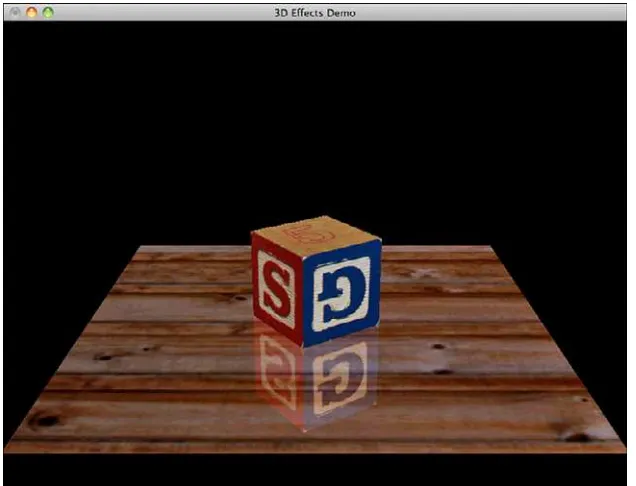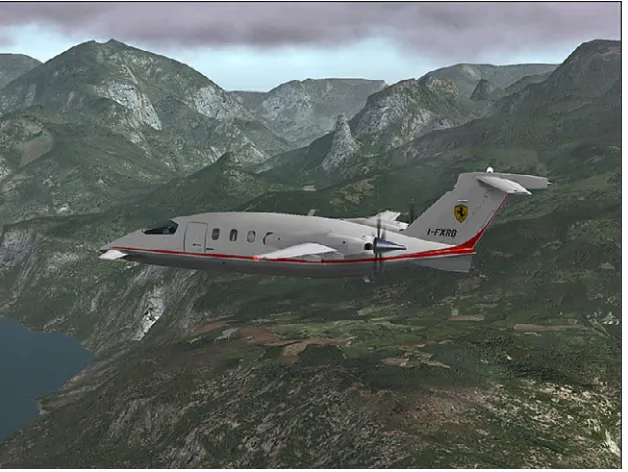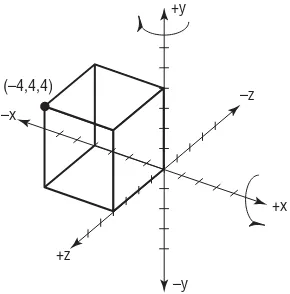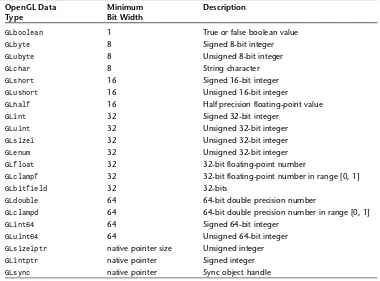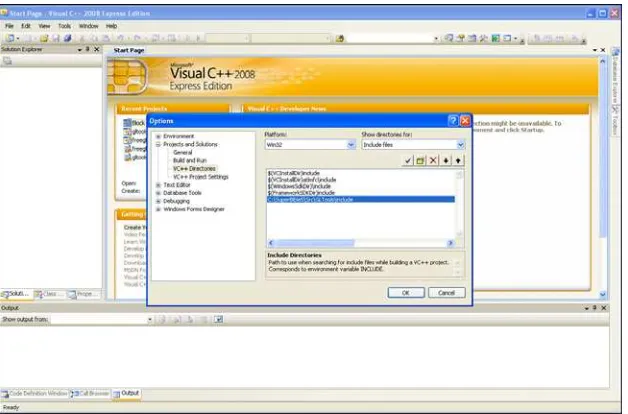I. Introduction to 3D Graphics and OpenGL
This chapter serves as an introduction to fundamental 3D graphics concepts and terminology for those new to the field. It lays the groundwork for understanding the OpenGL API by providing a historical overview of computer graphics, explaining the evolution from 2D to 3D rendering. Key terms such as transformations, projections, rasterization, shading, texture mapping, and blending are introduced, clarifying their roles within the 3D graphics pipeline. The chapter also explores common applications of 3D graphics, distinguishing between real-time and non-real-time rendering scenarios. This section's pedagogical value lies in its ability to bridge the gap between novice understanding and the more technical aspects of OpenGL programming, establishing a conceptual foundation for subsequent chapters. The discussion of coordinate systems, particularly the transition from 3D model space to 2D screen space, is crucial for visualizing how OpenGL transforms and renders 3D objects.
1.1 A Brief History of Computer Graphics
This subsection traces the development of computer graphics, highlighting key milestones and technological advancements. It provides context for understanding the current state of 3D graphics and OpenGL's place within that evolution. This historical perspective is valuable pedagogically as it illustrates the iterative nature of technological progress and the underlying principles that have remained consistent throughout the evolution of the field. This section's academic value lies in demonstrating how the field of computer graphics has developed from its humble beginnings to its current sophisticated state.
1.2 3D Graphics Techniques and Terminology
This section introduces core concepts of 3D graphics, defining key terms such as transformations, projections, rasterization, shading, texture mapping, and blending. Understanding these terms is essential for comprehending how OpenGL functions and interacts with 3D models. The pedagogical approach uses clear definitions and possibly illustrative diagrams to enhance comprehension. The section is academically valuable due to its precise explanation of fundamental concepts in 3D computer graphics, providing a robust basis for further learning.
1.3 Common Uses for 3D Graphics
This part explores the diverse applications of 3D graphics, separating them into real-time and non-real-time categories. This distinction highlights the different demands and capabilities required for each application type. The pedagogical value of this section lies in demonstrating the broad scope of 3D graphics and its impact across various industries and fields. The academic relevance is shown by demonstrating the versatility and far-reaching effects of 3D graphics technologies, including examples across different sectors.
1.4 Basic 3D Programming Principles
This section explains the fundamental principles of 3D programming and how they relate to OpenGL. It emphasizes the importance of coordinate systems and projections in translating 3D models onto a 2D screen. The focus on coordinate systems provides a solid foundation for understanding transformations and projections. Pedagogically, this part emphasizes the crucial relationship between mathematical concepts and their visual representations in OpenGL. The section's academic contribution lies in its precise explanation of core 3D programming principles and how they are applied to OpenGL programming.
II. Getting Started
This chapter introduces the OpenGL API, tracing its evolution and discussing its licensing and conformance. It explains the deprecation process and the future direction of OpenGL. The practical application of OpenGL is demonstrated through the creation of a simple program, providing a hands-on introduction to setting up projects, including paths, creating projects, and adding files for both Windows and Mac OS X environments. The chapter also covers basic OpenGL API specifics, error handling, version identification, and the OpenGL state machine. The chapter's pedagogical approach focuses on practical application through the creation of a functioning program, making abstract concepts tangible. The emphasis on error handling and state management is particularly important for developing robust and stable OpenGL applications. The academic contribution lies in understanding OpenGL architecture, and how to work with the API practically.
2.1 What is OpenGL?
This subsection provides a definition and overview of OpenGL, explaining its purpose and role in 3D graphics. The historical context adds depth to the understanding of OpenGL's design and evolution. This section’s pedagogical value lies in providing a clear and concise introduction to the core concept of the OpenGL API. The academic value lies in understanding the history and motivations behind the design of OpenGL, and its impact on the industry.
2.2 Using OpenGL
This section covers the practical aspects of using OpenGL, including setting up projects on different operating systems and creating a simple triangle. The step-by-step guide makes the process accessible to beginners. The pedagogical approach is highly practical, focusing on concrete examples and code snippets. The academic contribution is shown by the discussion of important concepts such as error handling and the OpenGL state machine.
III. Basic Rendering
This chapter delves into the basic rendering pipeline, explaining the client-server architecture and the role of shaders. It covers setting up coordinate systems, using orthographic and perspective projections, and working with stock shaders. The practical application focuses on rendering points, lines, and triangles in 3D, including techniques for handling unwanted geometry and polygon offset. The chapter also introduces blending, color combination, and antialiasing techniques using multisampling. The pedagogical value of this chapter lies in providing a clear and practical understanding of the rendering process. The inclusion of troubleshooting tips for common issues, such as unwanted geometry, adds practical value. The academic contribution comes from the explanation of the rendering pipeline and how to use its different components effectively.
3.1 The Basic Graphics Pipeline
This subsection explains the fundamental stages of the 3D graphics pipeline, highlighting the interaction between the CPU and GPU. The conceptual overview provides a framework for understanding the rendering process. The pedagogical value of this section lies in providing a clear and concise explanation of a complex process. The academic value is demonstrated by the explanation of the core components of the graphics pipeline and their interactions.
3.2 Setting Up Your Coordinate System
This section explains how to define and manage coordinate systems in OpenGL, covering both orthographic and perspective projections. The practical examples make these concepts easier to grasp. The pedagogical value of this section comes from showing how to set up a coordinate system correctly, and explaining why it’s important. The academic contribution lies in demonstrating the importance of coordinate systems in computer graphics and how different projection methods affect the final rendered image.
3.3 Using the Stock Shaders
This part introduces the concept of shaders, focusing on the attributes and uniforms that define their behavior. The practical examples illustrate how to use stock shaders for basic rendering. The pedagogical approach is hands-on, with a focus on using pre-built shaders before moving on to more complex custom shaders. The academic contribution is shown by the explanation of the roles of attributes and uniforms in shader programs and how they impact the rendering process.
3.4 Connecting the Dots
This section details the process of rendering basic geometric primitives (points, lines, and triangles) and handling common rendering challenges like unwanted geometry. The clear steps and illustrative examples aid in comprehension. The pedagogical value of this section lies in providing step-by-step instructions for rendering basic shapes, and resolving common issues. The academic contribution is in the detailed discussion of rendering techniques such as polygon offset, and advanced techniques like scissor tests.
3.5 Blending and Antialiasing
This part covers techniques for blending colors and antialiasing rendered objects to improve visual quality. The practical examples demonstrate how to implement these techniques. The pedagogical approach uses simple examples to illustrate these concepts. The academic contribution is in the explanation of the underlying mathematics and the practical implementation details of these techniques.
IV. Basic Transformations: A Vector/Matrix Primer
This chapter introduces the mathematical foundations of 3D transformations, covering vectors and matrices. It explains concepts like eye coordinates, viewing transformations, modeling transformations, and projection transformations. The chapter explains how to construct and apply modelview matrices, demonstrating how to create various 3D objects (sphere, torus, cylinder, cone, disk) and manage the transformation pipeline. The chapter also covers camera and actor management, including Euler angles and camera controls. The pedagogical value is evident in the breakdown of potentially daunting mathematical concepts into understandable and manageable components. The practical examples illustrating the application of transformations enhance comprehension. The academic contribution is in the thorough explanation of the underlying mathematical principles of 3D transformations and their crucial role in 3D graphics programming.
V. Basic Texturing
This chapter covers the fundamentals of texture mapping, starting with raw image data and pixel packing. It explains pixmaps, packed pixel formats, and methods for saving and reading pixel data. The chapter demonstrates how to load and apply textures, manage texture objects, and use texture coordinates and parameters. It also covers more advanced techniques like mipmapping, anisotropic filtering, and texture compression. The pedagogical value lies in providing a practical guide to implementing textures, going from fundamental concepts to advanced techniques. The academic contribution is in the explanation of various texture mapping techniques and their applications, including performance optimization using mipmaps and texture compression.
VI. Thinking Outside the Box: Nonstock Shaders
This chapter introduces the OpenGL Shading Language (GLSL), covering variables, data types, and storage qualifiers. It guides readers through the process of creating, compiling, binding, and linking shaders, providing practical examples of shader usage. The chapter explores built-in functions, lighting simulations (simple diffuse lighting, point light diffuse shader, ADS light model), and accessing textures. The pedagogical approach uses step-by-step instructions and clear explanations, making the process of shader creation accessible. The academic contribution lies in explaining the structure and syntax of GLSL and showing how to implement various shading effects.
VII. More Advanced Texture Topics
This chapter explores advanced texture techniques such as rectangle textures, cube maps (including skybox and reflection implementations), multitexturing, point sprites, texture arrays, and texture proxies. The pedagogical value comes from expanding on the basic concepts of texturing introduced earlier. The academic value is shown through the discussion of more advanced texture techniques and their applications in creating complex visual effects. Each technique is explained clearly and illustrated with practical examples.
VIII. Buffer Objects: Storage Is Now in Your Hands
This chapter discusses the use of buffer objects for storing and managing data within OpenGL. It explains how to create, fill, and use various types of buffer objects, including pixel buffer objects (PBOs) and texture buffer objects (TBOs). The chapter also covers framebuffer objects (FBOs) and renderbuffer objects, enabling off-screen rendering. The pedagogical value lies in explaining how to effectively use buffer objects to improve performance and manage data more efficiently. The academic contribution is in the discussion of modern OpenGL data management techniques using buffer objects.
IX. Advanced Buffers: Beyond the Basics
This chapter builds upon the previous chapter by exploring advanced buffer techniques, such as mapping buffers, copying buffers, and controlling pixel shader outputs. It explains new data formats introduced in modern OpenGL, including floats, multisampling, integers, and sRGB, as well as texture compression. The pedagogical value comes from expanding on the basic buffer object concepts by providing a comprehensive approach to more advanced techniques, while the academic contribution comes from the detailed explanation of these advanced concepts.
X. Fragment Operations: The End of the Pipeline
This chapter explains fragment operations that occur after the fragment shader has processed data. It covers scissoring, multisampling, sample coverage, sample mask, stencil operations, depth testing, depth clamp, blending, and masking output (color, depth, stencil). The pedagogical value lies in demonstrating how to control the final output of the rendering pipeline, enhancing the quality and control of visual effects. The academic contribution is shown by the detailed explanation of per-fragment operations, expanding the reader's knowledge of the rendering pipeline beyond the shader stage.
XI. Advanced Shader Usage
This chapter covers advanced shader techniques, including advanced vertex shaders (e.g., physical simulation), geometry shaders (pass-through, modification, generation, primitive type changes), and advanced fragment shaders (post-processing, image data generation, discarding work, depth control). It also explores uniform buffer objects (UBOs) for efficient uniform data management. The pedagogical value lies in demonstrating practical applications of geometry shaders and advanced shading techniques. The academic contribution is in the discussion of the more advanced shader techniques and their applications in achieving complex visual effects.
XII. Advanced Geometry Management
This chapter focuses on techniques for efficient geometry management, including using OpenGL queries to gather pipeline information, measuring execution time, storing data in GPU memory (vertex data, vertex indices, vertex array objects), instanced rendering, transform feedback, and synchronizing rendering operations. The pedagogical value is evident in demonstrating techniques for optimizing performance when dealing with large amounts of geometry. The academic contribution is shown by the explanation of techniques for optimizing geometry processing, enhancing performance and efficiency in complex scenes.
XIII. OpenGL on Windows
This chapter provides a detailed guide to using OpenGL on the Windows platform. It covers OpenGL implementations, extended OpenGL and WGL extensions, basic Windows rendering techniques using GDI device contexts and pixel formats, and creating OpenGL rendering contexts. It demonstrates how to create windows, implement full-screen rendering, and utilize double buffering for smooth animations. The pedagogical value lies in providing practical guidance on setting up OpenGL projects within the Windows environment. The academic contribution is shown by the comprehensive coverage of Windows-specific considerations when working with OpenGL.
XIV. OpenGL on OS X
This chapter focuses on using OpenGL on macOS, covering different approaches such as OpenGL with Cocoa, creating Cocoa programs, and wiring them with OpenGL. It discusses double and single buffering, full-screen rendering, and CGL for low-level interaction. The pedagogical value lies in providing specific guidance for macOS OpenGL development. The academic contribution is in the explanation of how OpenGL interacts with the macOS environment.
XV. OpenGL on Linux
This chapter covers OpenGL implementation on Linux systems, including an overview of X Windows, setting up Mesa and hardware drivers, using GLUT and GLEW, and interfacing with GLX. It covers aspects such as display management, context management, and synchronization. The pedagogical value is in providing a practical introduction to OpenGL development on Linux. The academic contribution lies in providing a detailed explanation of the interaction between OpenGL and the X Window System.
XVI. OpenGL ES on Mobile Devices
This chapter focuses on OpenGL ES for mobile devices, specifically targeting iOS (iPhone, iPad, iPod Touch). It explores the differences between OpenGL and OpenGL ES, discusses application design considerations for mobile environments, and covers EGL for window management and context creation. The pedagogical value is in guiding developers towards successful implementation of OpenGL ES applications on iOS devices. The academic contribution is in the explanation of OpenGL ES and its adaptation for resource-constrained environments.

